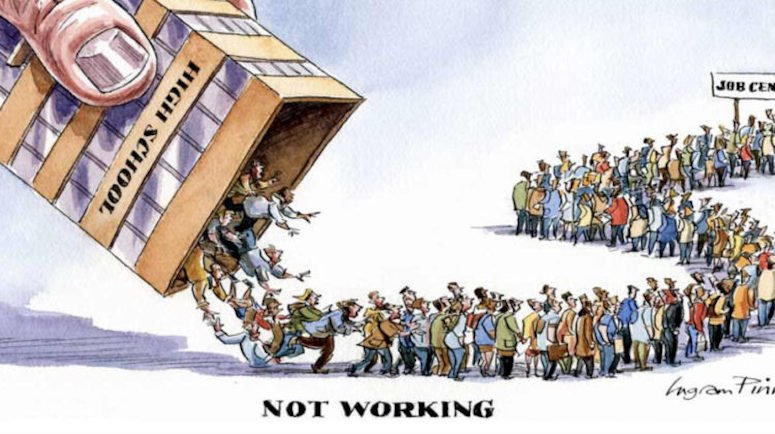Why in news?
According to data published by the Centre for Monitoring Indian Economy (CMIE), India’s unemployment rate reached a four-month high of 7.9% in December 2021.
- Due to rise in Covid-19 cases a number of states imposed fresh curbs so the economic activity and consumption levels have been affected. This will negatively affect economic recovery in the future.
Unemployment-
- The term Unemployment refers to condition of one who is capable of working, actively searching for work but unable to find work. Unemployment reveals the health of the economy.
- Unemployment rate- The unemployment rate is the number of people unemployed divided by the number of people working under labour force (working population).
- National Sample Survey Organisation (NSSO) defines employment and unemployment on the following activity statuses of an individual,
- Working (engaged in an economic activity) = Employed.
- Searching or available for work= Unemployed.
- Neither searching nor available for work.
- The first two constitute the labour force and unemployment rate is the percent of the labour force that is without work.
Unemployment rate = (Unemployed Workers / Total labour force) × 100
Types of Unemployment in India-
- Disguised Unemployment– It is a type of unemployment where people employed are more than actually needed. It can be seen mostly in agricultural and the unorganised sectors of India.
- Seasonal Unemployment- In this type of unemployment, people do not have work during certain seasons of the year. For example agricultural labourers in India.
- Cyclical Unemployment- It is a situation which occurs due to the business cycle, where unemployment rises during recessions and declines with the growth of the economy. This phenomenon is mostly found in capitalist economies so in India these figures are negligible.
- Structural Unemployment- In this type of unemployment there is a mismatch between the jobs available in the market and the skills of the available workers in the market. Many people in India do not get jobs due to lack of required skills and because poor education level, it becomes difficult to train them.
- Vulnerable Unemployment- This category is, people who are working informally means without any proper job contracts and there is no any maintained job records. Thus working without any legal protection. This is one of the main types of unemployment in India.
- Technological Unemployment- when due to advancement in technologies, people lose their jobs that situation is considered as Technological Unemployment. According to the World Bank’s prediction of 2016, the proportion of jobs threatened by automation in India is 69% year-on-year.
- Frictional Unemployment- It is a short span of time when an individual is searching for a new job or switching between jobs. It is also referred as Search Unemployment, is the time lag between the jobs. It is considered as voluntary unemployment because the reason for unemployment is not a shortage of jobs but in fact, the workers themselves quit their jobs in search of better opportunities.
Causes of Unemployment in India-
- Rapid Growth of Population- There is a constant increase in population of India, which is the main cause of unemployment.
- Social Factors- The caste system is prevalent in India due to which the work is prohibited for specific castes in some areas. Joint Family System encourages disguised unemployment. In big joint families having large business, there are many such persons available who do not do any work and depend on the joint income of the family.
- Defects in Education System- According to 2011 census, the literacy rate of India is 74.04 per cent, which is rising compare to the last few decades, but still there is a fundamental flaw in the education system because it does not provide the required training and specialisation for jobs which results into unemployment.
- Dominance of Agriculture- In India, nearly 51% workforce is dependent on Agriculture but its contribution is meagre in the GDP of country. One of the reason is agriculture is underdeveloped in India.
- Decline of Cottage and Small industries- British government policies curtailed the growth of small scale and cottage industries of India even after independence India’s preference to large scale industry had adversely affected the cottage and small industries.
- Immobility of Labour- There is very less labour mobility in India. Due to attachment to the family, people usually do not prefer to go far areas for jobs. Some factors like diversity of language, religion and customs and climate are also responsible for low mobility.
Way Forward-
- Decentralisation of Industries- India should focus more on decentralisation of Industrial activities so that people of every region get employment. Similarly development of the rural areas will help lighten the burden of migration of the rural people to the urban areas and decreasing the pressure on the urban area.
- Changes in investment patterns- There should be more focus investment allocation patterns. By focusing on the consumer goods industry there will be more job creation and it will absorb the unemployed.
- Promotion of Labour Intensive Industries- There are several labour intensive manufacturing sectors in India such as food processing, wood manufacturers and furniture, leather and footwear, textiles and apparel and garments. There is a need of special packages, individually designed for each industry to create jobs.
